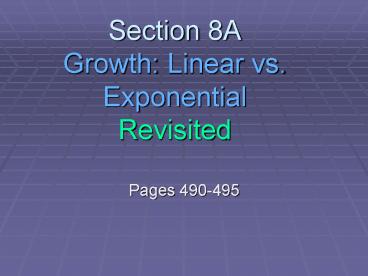Section 8A Growth: Linear vs. Exponential Revisited PowerPoint PPT Presentation
1 / 15
Title: Section 8A Growth: Linear vs. Exponential Revisited
1
Section 8AGrowth Linear vs. ExponentialRevisite
d
- Pages 490-495
2
Growth Linear versus Exponential
8-A
Linear Growth occurs when a quantity grows by
some fixed absolute amount in each unit of
time. Example Straighttown -- 500 each
year Exponential Growth occurs when a quantity
grows by the same fixed relative amountthat is,
by the same percentagein each unit of
time. Example Powertown -- 5 each year
3
Linear or Exponential Growth?
8-A
- In 1960, an acre of barley in the US yielded 31.0
bushels of grain. Since 1960 the yield has grown
by 1.7 each year. - Which kind of growth is this?
- Exponential Growth
- How much grain is yielded per acre in 2000?
- 31.0 x (1.017)40 60.8 bushels
4
Linear or Exponential Decay?
8-A
- The number of freshman entering Hollins has
increased by 15 students in each of the past 4
years. - Which kind of growth is this?
- Linear
- If 900 freshman entered Hollins in 2002, what
was the enrollment current enrollment of
freshman? - 900 (4 years 15 students/year) 960
5
Linear or Exponential Decay?
8-A
Population of chinook salmon along the west coast
of the North America has declined over the last
century. In 1967 approximately 86,500 salmon
swam up the ladders. Since then the chinook run
has declined at an average rate of 18.1 a
year. Which type of growth is this? Exponential
Decay pop. in 1968 86,500-.181(86,500)
86,500(1-.181)
86,500(.819)
6
8-A
What is the salmon population in 1990? pop. in
1990 86,500(.819)23 876 salmon
7
Parable 3 Bacteria in a Bottle
8-A
Single bacteria in a bottle at 1100 am 2
bacteria at 1101 4 bacteria at 1102 8
bacteria at 1103 . . . Bottle is full at
1200 (an hour later). Q1 How many bacteria
are in the bottle then? 260 1.15 x1018
8
Parable 3 Bacteria in a Bottle
8-A
Single bacteria in a bottle at 1100 am 2
bacteria at 1101 4 bacteria at 1102 8
bacteria at 1103 . . . Bottle is full at
1200 (an hour later). Q2 When was the bottle
half full? At 1159!
9
Parable 3 Bacteria in a Bottle
8-A
Q3 If you warn the bacteria at 1156 of the
impending disaster - will anyone believe you?
½full at 1159 ¼ full at 1158 ? full at 1157
full at 1156 the amount of unused space
is 15 times the amount of used space The bottle
fills VERY rapidly in the last 3 minutes.
10
Parable 3 Bacteria in a Bottle
8-A
Q4 At 1159 the bacteria spread to 3 more
bottles. Now that they have 4 total bottles to
fill, how much time have they gained? There are .
. . enough bacteria to fill 1 bottle at
1200 enough bacteria to fill 2 bottles at 1201
enough bacteria to fill 4 bottles at 1202
Theyve gained only 2 additional minutes!
11
Parable 3 Bacteria in a Bottle
8-A
By 100- there are 2120 bacteria. This is
enough bacteria to cover the entire surface of
the Earth in a layer more than 2 meters deep!
After 5 ½ hours, at this rate . . . the volume
of bacteria would exceed the volume of the known
universe.
12
Key Facts about Exponential Growth
8-A
Exponential growth cannot continue
indefinitely. After only a relatively small
number of doublings, exponentially growing
quantities reach impossible proportions.
Exponential growth leads to repeated doublings.
With each doubling, the amount of increase is
approximately equal to the sum of all preceding
doublings.
13
Repeated Doublings
8-A
14
Key Facts about Exponential Growth
8-A
Exponential growth cannot continue
indefinitely. After only a relatively small
number of doublings, exponentially growing
quantities reach impossible proportions.
Exponential growth leads to repeated doublings.
With each doubling, the amount of increase is
approximately equal to the sum of all preceding
doublings.
15
- Homework for Wednesday
- Page 496
- 6, 13, 16, 22, 26

